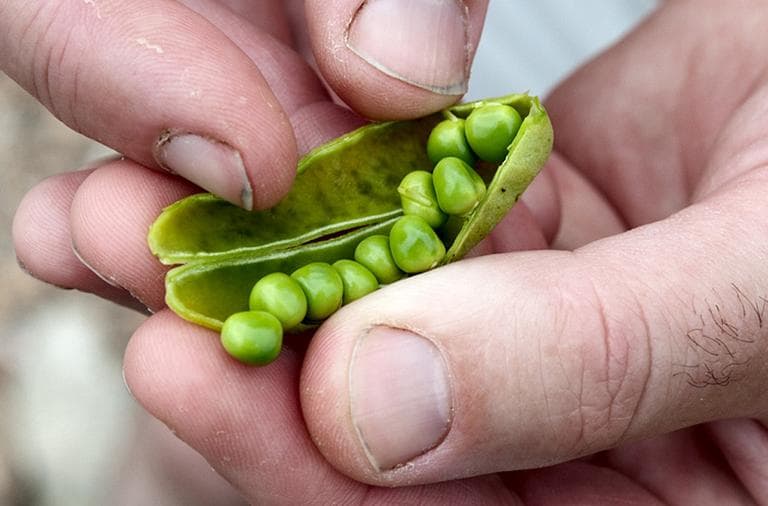Advertisement
Foraging Fever
ResumeJacki Lyden in for Tom Ashbrook
Foraging fever. From the woods to cracks in the pavement, the search for edible delights.

Bladderwrack on the beach. Chicken of the Woods. Purslane, Sheeps Sorrel. Are we hungry yet? Foraging has become cachet internationally as we pursue the overlooked bounty of nature in ditches, meadows and backyards.
Elderberry wine is one thing. But cooking stinging nettles, mashing up acorns, boiling up burdock ? More and more high end restaurants have professional foragers on staff, foraging classes have grown, and we explore from Denmark’s coast to British woods to a patch of ground near you.
This hour, On Point: Foraging. Gathering. And consuming it.
-Jacki Lyden
Guests
Jane Kramer, staff writer at The New Yorker, her article in this week’s issue of The New Yorker is The Food at Our Feet: Why is Foraging All the Rage?
Hank Shaw, and author of Hunt, Gather, Cook: Finding the Forgotten Feast.
David Craft, an urban forager for five years. He's the author of Urban Foraging: Finding and Eating Wild Plants in the City.
From The Reading List
The Washington Post "We aren’t even 20 feet down my street when Hank Shaw stops to pick up one of the thousands of little brown nuts a neighbor’s tree dropped earlier that week."
The New Yorker "I wasn’t the first throwback on the block. The pursuit of wild food has become so fashionable a subject in the past few years that one eater.com blogger called this the era of the “I Foraged with René Redzepi Piece.” Redzepi is the chef of Noma, in Copenhagen (otherwise known as the best restaurant in the world). More to the point, he is the acknowledged master scavenger of the Nordic coast. I’ll admit it. I wanted to forage with Redzepi, too."
Hank Shaw's Blog Hunter Angler Gardener Cook "I write. I fish. I dig earth, forage, raise plants, live for food and kill wild animals. I drink bourbon, Barolo or Budweiser with equal relish and wish I owned a farm, or at least a large swath of land I could play on."
David Craft's Urban Foraging Blog "It's Kousa Dogwood season and this is a good year for them. After stats class at Harvard last night (which I am barely following, but I find the nerd level entertaining) I noticed a great kousa (there are lots in Harvard yard) right next to my bike so I loaded up."
Recipes
1 part vinegar
1 part water
Bring this to a boil and add some pickling spices and salt. I like whole black peppercorns and red pepper flakes.
Add enough tender knotweed (first couple weeks of growth, whole stalk; after that, just the top section that easily breaks off) so that it is just covered. Remove from the flame. It does not need to cook at all, just being plunged in the boiling water vinegar solution is fine.
Put into sterilized mason jars. Ready for consumption as soon as they cool off! Great in salads.
Elderflower ice cream is a subtly flavored ice cream that you have to smell to really appreciate. It is equally good with fresh or dried elderflowers, although if you use dried elderflowers you should make sure they are not too old — old flowers begin to smell musty. I also add a little elderflower syrup, too, but you can skip this if you want.
Make sure that if you use fresh elderflowers to remove all the stems. Most dried elderflowers already have their stems removed.
Makes about 1 quart
Prep Time: 12 hours, most of it inactive
Cook Time: 20 minutes
* 2 cups heavy cream
* 2 cups whole milk
* 1/2 cup dried elderflowers, or 1 cup fresh
* 1/4 cup elderflower syrup (optional)
* 3/4 cup sugar
* 4-5 egg yolks
1. Heat the cream, milk, sugar and elderflowers in a heavy pot set over medium heat. Bring to 160 degrees — steaming, but not simmering — and turn off the heat. Stir in the elderflower syrup, if using. Cover and allow to cool to room temperature, and then pour into a container and allow to steep overnight, or at least 6 hours.
2. Pour the cream mixture back into a pot and bring back to 160 degrees. Put the egg yolks into a bowl and get a whisk and a ladle. Temper the eggs by slowly whisking in a ladle of the hot cream mixture, then another. Pour the tempered egg yolks into the cream mixture and allow to heat for 5-10 minutes. Do not let this simmer.
3. Strain through a fine-meshed sieve and cool once again. Pour into your ice cream maker and follow its directions.
This program aired on November 18, 2011.